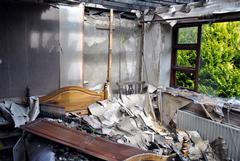
Fire restoration projects are critical for restoring and rebuilding properties after a devastating fire. However, during the restoration process, it's essential to prioritize security to safeguard the property, protect workers, and maintain a safe environment. In this blog post, we'll explore the key steps and considerations for ensuring secure environments during a fire restoration project, focusing on protecting the property, mitigating potential risks, and promoting safety for everyone involved.
Assessing Security Needs
Before commencing a fire restoration project, a thorough assessment of the property's security needs is crucial. Consider the following factors:
Property Access and Control: Determine the level of access control required during the restoration process. Establish secure entry points, limit access to authorized personnel only, and install temporary security measures such as fencing, locks, and surveillance cameras if necessary.
Asset Protection: Identify valuable assets and possessions that need protection during the restoration project. Take inventory of items, secure them in safe storage areas, and implement tracking measures to ensure their safekeeping.
Security Personnel: Evaluate the need for security personnel on-site. Depending on the scale of the project and the property's location, hiring trained security professionals can provide an added layer of protection and surveillance.
Implementing Safety Measures
In addition to property security, safety measures should be a top priority during a fire restoration project. Consider the following measures to mitigate potential risks:
Hazard Identification and Mitigation: Conduct a thorough assessment of the property for potential hazards, such as structural weaknesses, electrical hazards, or hazardous materials. Address these issues promptly and ensure all workers are aware of potential dangers.
Safety Equipment and Training: Provide appropriate personal protective equipment (PPE) to all workers and ensure they receive proper training on its usage. This includes safety helmets, gloves, goggles, respirators, and fire-retardant clothing as needed.
Fire Safety Measures: Establish and communicate fire safety protocols on-site. Install temporary fire extinguishers and ensure their accessibility. Conduct fire drills and train workers on evacuation procedures and the use of fire safety equipment.
Adhering to Codes and Regulations: Familiarize yourself with local building codes and regulations pertaining to fire restoration projects. Ensure that the restoration work meets all safety requirements and obtain necessary permits as required.
Protecting Sensitive Information
During a fire restoration project, it's essential to safeguard sensitive information to prevent potential security breaches. Consider the following measures:
Data Protection: Identify and secure any sensitive or confidential data that may be present in the property. This includes physical documents, computer systems, and any other storage devices. Implement secure storage and data encryption measures as needed.
Document Handling and Disposal: Establish protocols for handling and disposing of documents during the restoration process. Use secure containers for document disposal and employ shredding services when necessary to prevent unauthorized access to sensitive information.
Collaboration and Communication
Effective collaboration and communication among all stakeholders are vital for maintaining a secure environment during a fire restoration project:
Project Coordination: Foster open communication and coordination between the property owner, restoration team, security personnel, and any other involved parties. Clearly define roles, responsibilities, and lines of communication to ensure everyone is on the same page.
Regular Updates: Provide regular project updates to the property owner regarding security measures, progress, and any potential security risks that may arise during the restoration process. This promotes transparency and enables prompt decision-making.
Emergency Response Planning: Develop an emergency response plan that outlines procedures for various scenarios, including security breaches, accidents, or natural disasters. Train all personnel on the emergency response protocols and ensure they have access to emergency contact information.
Ensuring secure environments during a fire restoration project is paramount for protecting the property, minimizing risks, and promoting the safety of all individuals involved. By conducting a thorough security assessment, implementing safety measures, protecting sensitive information, and fostering collaboration and communication, you can create a secure environment that enables a smooth and successful restoration process. Remember, prioritizing security and safety is essential for achieving a successful outcome and restoring the property to its pre-fire condition.

